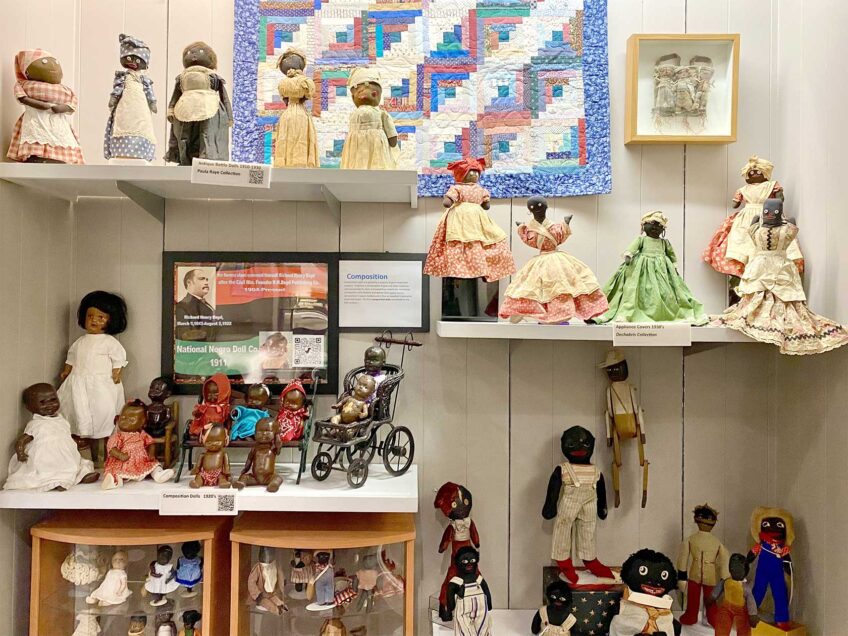

Charles LeDray’s “Party Bed” (2006-2007), from the Cartin Collection.
The impulse to order one’s world is particularly urgent to an artist. Charles LeDray does just that, one stitch at a time.
Instead of relying on ready-made objects or enlisting cadres of assistants to fabricate his designs, New York-based LeDray, 50, sews, hooks, casts, binds, throws, glazes, carves and constructs his works himself. The objects number in the thousands and most are less than two inches high — but they have monumental expressive power.
Moral energy as well as a profound work ethic infuses the magnificent exhibition at the Institute of Contemporary Art Boston until Oct. 17. The 50 installations and sculptures on view in nine galleries show the power of one person’s seemingly humble activity — domestic handiwork — to repair and order a chaotic world.
Organized by ICA Associate Curator Randi Hopkins and initiated by former ICA curators Nicholas Baume and Jen Mergel (Mergel is now head curator of contemporary art at the Museum of Fine Arts Boston), the exhibition will travel to the Whitney Museum of American Art in New York and after, to the Museum of Fine Arts, Houston.
Suggesting LeDray’s nonstop, monk-like dedication to both process and finished objects, the show and its catalog share the title “CHARLES LEDRAY: workworkworkworkwork,” also the name of one of his installations.
Born in Seattle, LeDray learned to sew at age 4 from his mother and soon mastered knitting and macramé. If these skills were social liabilities in junior high, they became assets when he arrived, a self-taught artist, in New York in 1989 as knitting, sewing and other homegrown crafts were gaining cachet in arts schools and galleries.
Paradox is at the heart of LeDray’s work and key to its emotional power and mystery. Reconciling seeming opposites, he meticulously observes and renders what is worn, familiar, forgotten or cast off and endows the objects and their users with gravity. He crafts fragile and frayed objects from scratch and displays them like precious relics, pressed under glass or shown in bell jars or display cases he makes himself.
Tiny dresses and pants hang like rag dolls or skip and dance and suggest the presence of people. In a teeming variety of colors, textures and styles, he displays work garb, party wear, uniforms and daily outfits that convey their wearers’ passions, whims, loyalties, obligations. His outfits also express a variety of emotions and moods. A riotous array of plaids, ginghams, fake fur, faux leopard skin, florals, camouflage cloth, denim and polka dots celebrate life in its abundant variety. Other works honor absence and loss.
In the first gallery, “Come Together” (1995-96) portrays a dream of social harmony. Over a denim jacket embroidered with rainbows, peace signs, doves, hearts, flowers and fish is a joyful arc of tiny outfits, their sleeves interlocked like people joining hands.
One of several self-portraits in miniature garb is “Charly/Chas” (1999-2002), a jacket on a wooden tree with a leather tool belt equipped with gloves, wrenches, tape, keys, screwdrivers.
Another autobiographic note is struck by the earliest work on view, “Family” (1985-88), a tender trio of stuffed animals. A protective mother bear and her beaming child ride a beribboned pony, a valiant group setting out on a journey. As later works show, the trip will have rough patches.
Some works from the 1990s suggest LeDray’s struggle to find his way as a gay man. “Untitled (Tar Bears)” (1991) shows two charred teddy bears mired in oily ooze. In “Untitled” (1992) a stuffed bear’s arms and legs are tangled and its eyes are white in bafflement.
A concise assertion of LeDray’s commitment to himself and his way of making art, “Becoming/Fight” (1992) is a miniature boxer’s robe in soft flannel trimmed with multicolored yarn.
Torn fragments of a fine tailored shirt, a symbol of conventional male order, are pressed under glass like precious relics in a 10-part series entitled “My Hands, My Fathers Hands” (1991). A sequence of men’s jacket-and-tie ensembles includes a shredded suit and one with an oval-shaped hole in its chest. In “Untitled (Suit with small suit cut from it)” (2000), a hole over the heart forms a silhouette of the new miniature jacket dangling from its cuff.
LeDray’s droll self-portraits include “Charles” (1995), a monogrammed workman’s jacket with an exuberant array of dresses, skirts, bras and coats dangling from its hem and cuffs. Like a flasher exposing private parts, “Overcoat” (2004) is a trench coat that opens to display a jumble of tiny outfits.
Handcrafted in great volume, LeDray’s tiny objects assert the value of individuals. No two are quite the same, like people and their acts of imagination — including their way of dressing.
More than 600 tiny objects are on display in “workworkworkworkwork” (1991). Arrayed like a sidewalk sale, the installation shows little groupings of fantastically detailed outfits. Viewers lean close in to examine the finely wrought T-shirts, shoe buckles and vests and read the covers of magazines with such titles as “Nerd,” “Doberman,” “Sin,” “Jocks” and “Sleazefest.”
Among the many wonders of this exhibition are LeDray’s two display cases of tiny, hand-thrown pottery. Seven years in the making, each contains 2,000 vessels in an endless variety of colors, shapes and markings — hearts, abstract swirls, geometric designs. Replicating pottery forms and styles from many eras and cultures, the displays are also a panorama of art history over the centuries that LeDray absorbed while working as a security guard at the Seattle Art Museum.
Sketches showing LeDray’s studies in form are also on display in exquisite, one-inch books that have cases lined with marbled paper.
Some works have a stark and elegant simplicity. Forging gold and carving ivory, LeDray created “Ring Finger” (2004), a replica of finger bones encircled by a wedding band.
LeDray also carves miniatures out of human bone. These figures include a rotating model of the sun, planets and moons; delicate buttons shaped into stars, moons and seashells; tiny versions of Shaker furniture; and a cricket cage with toothpick-size bars.
Like ghostly figures, a string of tiny garments strut, skip and stride along the edges of a long, pale banner in “Pride Flag” (1996), as if looking back at the gay rights movement through the lens of AIDS.
Installed in a darkened gallery, “Jewelry Window” (2002) displays black jewelry busts against a white, backlit wall in a diorama that suggests an abandoned stage set.
The masterwork of the exhibition is “Men’s Suits” (2006-09). Occupying a large gallery, it creates three scenes in a men’s used clothing shop. Standing about four feet high, each tableau has its own suspended ceiling and stained tile flooring. Viewers can see the dust (inserted by LeDray) on the ceilings and their bars of fluorescent lights. One space is a sorting room with racks, hangers, wood palettes, carts, an ironing board, a broom, and a stray sock along with bags and stacks of newly arrived clothes.
Storefront areas show a pinwheel of ties, a jacket and tie ensemble of mismatched plaids, stacks of t-shirts and circle racks with an astonishing array of shirts and jackets. Many are tired, tatty and garish; but all are displayed with pride, restored and ready for other users. The scenes dignify the garments, their past and future owners, and the workers who prepare the clothes. Lit in a fluorescent glow, LeDray’s thrift shop is as moving as a painting of peasant life by Jean-François Millet.


![Banner [Virtual] Art Gallery](https://baystatebanner.com/wp-content/uploads/2024/04/Cagen-Luse_Men-at-store-e1713991226112-150x150.jpg)

![Banner [Virtual] Art Gallery](https://baystatebanner.com/wp-content/uploads/2024/04/Cagen-Luse_Men-at-store-e1713991226112-848x569.jpg)

